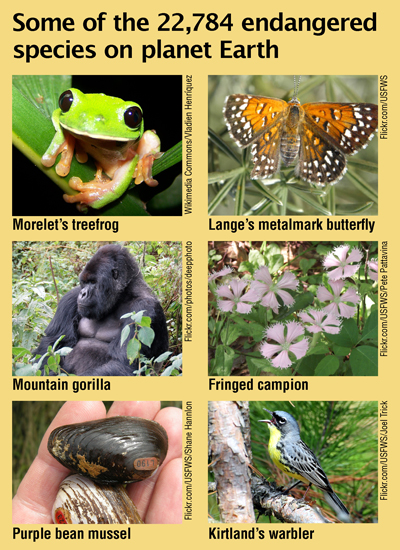The “Sixth Extinction” and the Future of Life on Planet Earth
by Orpheus Reed | July 6, 2015 | Revolution Newspaper | revcom.us

For many years, scientists and environmental groups have studied and tracked the decline of populations of wild species, as well as documenting the actual elimination, or extinction of species.
This decline has increased dramatically over the last hundred years or so. It is seen across many kinds of species we may know—elephants, lions, apes, tigers, many species of amphibians, birds, many types of fish, polar bears, etc. It’s also happening with many other kinds of species we don’t see or know—including invertebrates, plants, even microorganisms. The decline of populations of organisms in a species is very much tied to making that species vulnerable to going out of existence in the wild. The International Union for the Conservation of Nature (IUCN) for example has assessed 77,340 species worldwide and says 22,784—more than one-quarter—are threatened with extinction.
Extinction is known from the fossil record. It’s estimated that more than 90 percent of all species that have ever existed on the planet are now extinct. So extinction over really long periods of time is normal and happens constantly throughout the Earth’s history. Extinction in more modern times is known from the written records of human history—particularly over the last 500 years or so.
What Is Mass Extinction?
Among scientists, there has been debate and now a growing agreement that today, the Earth is experiencing an increase in species extinction far above normal, or “background,” rates of extinction. Now, vast declines of populations of organisms, and even in some cases their actual extinction, is being observed more or less in front of our eyes, in other words, taking place over decades, and in some cases even shorter periods. The Caribbean monk seal, the passenger pigeon, the Tasmanian tiger—are just some of hundreds of species driven to extinction over the last hundred years or so.
Many scientists have warned that this current level of extinction is a crisis, and that we are approaching, or already in, the “sixth mass extinction” in Earth’s history.
A mass extinction is one that causes a big increase in the death of species of various types (what biologists call higher “taxa”—or biological units higher than the species unit) over more than one geographical area during a relatively short period of “geologic time.” A short period of geologic time means not years or even hundreds of years, but short compared to the 4.6 billion year history of the Earth.
The previous five mass extinctions have been caused by natural phenomena, such as the asteroid strike now thought to have triggered the extinction of dinosaurs and much other life 65 million years ago. This was the last mass extinction event. The previous mass extinctions killed off huge percentages of life, ranging from maybe a quarter of all life to as high as 90 percent in the Permian extinction. (See National Geographic’s “Mass Extinctions: What Causes Animal Die-Offs?”) The current sixth mass extinction event is not due to natural causes—it is being caused by human activity. As such, it is not necessary, and it could be stopped. It is also not the result of “human nature.” It is primarily driven today by the way human society is organized under capitalism, and the corresponding social relations, ideology, and culture of this system. The predations of modern capitalism and its relentless hunt for profitability through vicious competition and endless wasteful economic “growth,” its fostering of consumerism, its ethic of “getting ahead” and the truly miserable dog-eat-dog conditions of survival for vast sections of humanity capitalism-imperialism creates are killing off life and threatening extinctions at an extremely rapid rate.
The “Sixth Extinction”—Why it Matters
A new study published this June in Science Advances, “Accelerated modern human-induced species losses: Entering the sixth mass extinction,” provides further evidence that we have likely entered a period of a sixth mass extinction caused by human destruction. This is a very big deal with huge ramifications for the continued existence of the vast diversity and beauty of the natural world, and for humanity’s continued survival.
Ecosystems are complex webs of interacting, interrelating, and interdependent life. Extinction of species, and destruction of habitat, along with many other forms of environmental destruction, can cause ecosystems to unravel in unpredictable ways as species that rely on each other are degraded or eliminated. And this can snowball. Adding up a series of ecosystem collapses globally can cause the world ecosystem to unravel or collapse. This is what is already beginning to occur and it’s accelerating. (See “Signs of an Accelerating, Out-of-Control Environmental Emergency,” at right.)
In comments to the press, the authors of the study very importantly made the point that the existence of diverse species and ecosystems and the “ecosystem services” they provide to humanity, (providing of food and clean water, nutrient cycling and crop pollination, control of climate and disease, and social appreciation of their beauty and diversity, etc.), are all threatened by the sixth extinction. Lead author Gerardo Ceballos warned humanity’s existence is at stake, saying, “If it is allowed to continue, life would take millions of years to recover, and our species itself would disappear early on.”
What Is Driving the Current Crisis—and What Is the Way Out?
As we pointed out in the special issue of Revolution on the environment, the environmental emergency has many interacting dimensions. When the destruction is traced to its cause, what jumps out is the workings of a whole capitalist system driven by laws of competition and profit-making. How so?
The leading causes of species extinction today are destruction of natural habitat, introduction of invasive species, overharvesting of species, and climate change.
We can’t go into the immense and awful picture of this in great detail, but to touch briefly on some important examples:
The oceans are being acidified and warmed from climate change caused by the fossil fuel energy foundation of capitalism. Coral reefs that are home to amazing swaths of marine life are being degraded and in some cases destroyed. The future existence of these reefs is in question. Huge populations of fish life are unsustainably overharvested, scooped up by giant trawling nets. This method is horribly destructive, but it’s quick and highly profitable. Big fishing interests are competing over who will grab up these “resources” first and in largest amounts. Huge quantities of fish as well as marine mammals and animals like sea turtles are killed and discarded as “bycatch.”
There are rules and regulations supposedly established to protect marine mammals in the oceans. But all the capitalist powers and corporations are continually driven to undermine these rules. Seismic blasting and ship traffic can devastate whales’ communication, cause them to go deaf, and disrupt their migration patterns. Oil spills wipe out marine life. But all these big interests are driven to find and exploit new sources of fossil fuels— a source of tremendous profitability, domination of economic life, and strategic power. So rules protecting marine life are continually pushed aside.
Migrations and disruptions of marine life are already underway as a result of climate change, warming oceans, and other factors. The same is occurring on land as well. It is as if our planet and its vast array of life is being grabbed like a snow globe and viciously shaken in a deadly experiment; no one knows how it will exactly play out.
A key form of habitat destruction is deforestation. The World Wildlife Fund (WWF) estimates that 46,000 to 58,000 square miles of forest are lost each year. Deforestation happens through fires, clear-cutting for agriculture, timber production, expansion of ranching, and development, and increasingly, degradation of forests through climate change. The current drought in California—at least partially a result of, or at least made worse by, climate change—has caused an estimated 12 million trees to die.
In the Amazon, forests are mowed down for cattle ranches, growing soybeans, and other development. Some species are already gone. A 2012 study said that five times more species than those already eliminated will inevitably go extinct because so much habitat has already been wiped out or degraded. The Amazon rainforest has historically contained some of the richest diversity on the planet. Now, various kinds of monkeys, birds, otters, and other species have been forced into smaller and smaller patches of land while trees and plants are also uprooted. This rainforest of immense beauty and a key source of regulation of climate, continues to be maddeningly, sickeningly cut down for profit. This is driven by the intensive competition among all the big powers and companies to turn nature into commodities before the others can. The vast ecological destruction this causes, the end of species, is just an externality to the cost/benefit analysis of capitalism.
In recent years the rate of destruction in the Amazon has gone down, but it still continues and could ramp up again. Faced with financial problems, there has been talk by the Brazilian government of a “rapid development program” that would construct 20 new hydroelectric power plants.
In Indonesia, some of the world’s greatest forests have been eliminated by burning off and clearing land for palm oil production and illegal logging. Endangered species like forest elephants, rare tigers and rhinoceros are being driven to extinction. This destruction, and that in the Amazon, Africa, Asia and elsewhere— is tied up with the interests of large capitalist agribusinesses, timber and mining companies, etc. In many cases it is financed and guided by international imperialist financial institutions, banks, and governments. In the case of Indonesia, U.S. backing of brutal military dictatorships has fostered indescribable horrors for the people and nature. (See “The Plunder of Rainforests of Indonesia and Malaysia”)
The destruction of forest habitat is also a genocidal attack on indigenous peoples and cultures. In March 2014, the Palangka Raya Declaration from forest communities in Kalimantan, Indonesia, said international negotiations on stopping deforestation were failing. Their declaration says: “The situation facing us and the planet is dire. The global deforestation crisis continues and recent scientific reviews show that forest loss is even accelerating, especially in tropical forest countries. This destruction does not just imperil the planet through climate change, loss of biodiversity and loss of ecosystem functions, it undermines our daily lives, our cultures, our own livelihoods and economies and sets in jeopardy all our futures.”
Destruction of habitat is continuing, relentless and pervasive, under capitalism. It restlessly and continually pushes out for new growth and development—new big box stores, housing developments, new industrial, power, and agricultural projects—without any long-term plan or based on any recognition of the limits of the natural world.
What is driving this process is not simply greed or “the corporations.” The destruction of habitat, the ravaging of the seas and their life, the threat to the whole planet and its people by climate change, are embedded in the essential dynamics of the capitalist system.
On the one hand, all of these capitalist powers and interests are highly organized to carry out their harvesting and production. But all of these interests are privately owned and in intense competition with each other to expand and grab up what they can as fast as they can and turn it into profit. They are in kill or be killed competition with all the others who are doing the same thing. There is a deep underlying contradiction between the highly globalized and organized character of the forces of production, and the completely irrational and unsustainable way this is all carried out because these interests are all owned privately and driven by competition. This sharp, embedded contradiction between the organized forces of production and the anarchic way this process must be carried out under capitalism is the essential force driving the plunder and destruction of the natural world. (See “On the ‘Driving Force of Anarchy’ and the Dynamics of Change. A Sharp Debate and Urgent Polemic: The Struggle for a Radically Different World and the Struggle for a Scientific Approach to Reality” by Raymond Lotta)
The destruction of habitat and species, and all else threatened by the sixth extinction, must be stopped and turned around. It is not yet too late to put an end to this whole trajectory and save world ecosystems and much of the planet’s biodiversity, But, a dramatic struggle starting now, and fundamentally revolutionary transformations, are required.
There is a way out. In contrast to capitalism, socialism moving toward communism could stop this destruction and move to protect ecosystems and people, and take steps to allow the natural world to recover and again flourish. Socialism does not have embedded in its essential makeup laws requiring it to treat nature as nothing but a thing, a “resource” or “prize” to be gutted and churned into production for profit. This would not be easy or magical. Much destruction of species and the natural environment has already been set loose and guaranteed by this destructive system. But the longer this continues, the worse it will get, even catastrophically so. Hard choices and transformations would face the new society requiring sacrifice and struggle. But there is a way out to protect both humanity and nature through revolution. The Constitution for the New Socialist Republic in North America (Draft Proposal) makes protection of the environment a central point of economic life. A new socialist society guided by this would plan sustainable economic development to meet the needs of the masses of humanity from the viewpoint of humanity acting as caretakers of the planet.
Volunteers Needed... for revcom.us and Revolution
If you like this article, subscribe, donate to and sustain Revolution newspaper.






